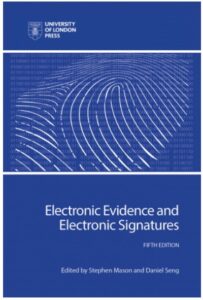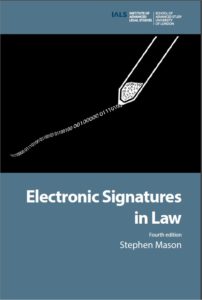The Office of the Prime Minister is reported to have sent a letter to the European Union requesting an extension of the period provided under Article 50(3) of the Treaty on European Union, under the terms of the European Union (Withdrawal) (No. 2) Act 2019, with a covering letter from United Kingdom Permanent Representative to the European Union, Sir Tim Barrow. (See https://www.bbc.co.uk/news/uk-50114538 for the text of each letter).
Apparently the letter sent is a photocopy of a draft letter (as reported by https://www.politicshome.com/news/uk/foreign-affairs/brexit/news/107397/boris-johnson-sends-photocopied-and-unsigned-letter-eu), and bears no hand written signature.This raises a number of legal issues:
First, whether a photocopy of a draft letter can be accepted as a document that is binding on the sender and can be relied upon by the recipient.
Second, whether a letter not bearing a handwritten signature can be considered to be signed.
Third, what legal effect, if any, the covering letter from United Kingdom Permanent Representative to the European Union, Sir Tim Barrow has on the unsigned photocopy.
1. Whether a photocopy of a draft letter can be accepted as a document that is binding on the sender and can be relied upon by the recipient
Under English law, a copy is admissible in legal proceedings. The best evidence rule is no longer relevant. (For a discussion of this topic in the context of digital data, see Stephen Mason and Daniel Seng, editors, Electronic Evidence (4th edn, Institute of Advanced Legal Studies for the SAS Humanities Digital Library, School of Advanced Study, University of London, 2017), open source at https://humanities-digital-library.org/index.php/hdl/catalog/book/electronicevidence.
It is debatable whether the legal jurisdictions of other EU Member States will consider that a photocopy of a draft letter is sufficient to be relied upon, especially for such an important political act. But they may consider that the legal position in English law governs the status of the document and its capacity to bind the UK.
2. Whether a letter not bearing a handwritten signature can be considered to be signed. This precise issue has arisen under English law in various circumstances:
(i) In a matter of the sale of a lease, in the case of Ogilvie v Foljambe (1817) 3 Mer 53; 36 ER 21, three undated letters were produced in court, one of which read ‘Mr Stanley begs to inform Mr Lobb …’. It was considered sufficient that he began the text with his name, and his name governed the promise that followed.
In Tourret v Cripps (1879) 48 LJ Ch 567; 27 WR 706, Mr R. L. Cripps wrote in his own hand on a sheet of memorandum paper an offer to lease parts of 14 and 15 Mortimer Street, Cavendish Square. The memorandum was not signed by him, but contained, at its head, the words ‘From Richd. L Cripps’ and his address. It was held that his printed name served as a signature to hold him to the promise he made.
(ii) Under the provisions of section 4 of the Statute of Frauds 1677 in the case of Lobb and Knight v Stanley (1844) 5 QB 574; 114 ER 1366; (1843–44), Law Times (2) 366, where an unsigned written promised was held to be signed.
(iii) In the case of Holmes v Mackrell (1858) 3 C.B. (N.S.) 789; 140 ER 953, a promissory note written in the hand of the defendant with his name written on top, but not signed at the end, was held to be a sufficient signature for the document.
Notwithstanding the above examples discuss documents written by hand and in the third person, the fact is, that:
‘It appears that judges, when dealing with cases where a promise was made that affected an innocent party, and the person making the promise subsequently sought to avoid being held to their promise by arguing a technical point that the promise was not signed, thus making it unenforceable, were, generally, not willing to allow the person making the promise to succeed on such a technicality.’ (Electronic Signatures in Law, 11.19)
In each of the cases noted above, the content was in manuscript a hand, which might cause people to conclude that a document written on a computer and then printed might not come within the examples. The case of Brydges (Town Clerk of Cheltenham) v Dix (1890–1) 7 TLR 215 is illustrative on this point (there are earlier examples relating to commerce). In this case:
‘the Cheltenham council required the town clerk to execute certain works. When the owner of the property refused, the council sent a notice to the owner on a printed form, duly filled in, with the name of the town clerk printed at the foot of the notice. The council subsequently undertook the work and then sought to recover their costs. Matters dealing with the authenticity of the notice were set out in s266 of the Public Health Act 1875…. An objection was taken that the signature of the clerk was a requisite and that it should be affixed by hand. The magistrates accepted this argument and refused to make an order for payment. Pollock B and Charles J heard the appeal in the Queen’s Bench Division. They allowed the appeal and came to the conclusion that if a signature was required, a manual signature was not necessary.’ (Electronic Signatures in Law, 1.100)
The printed signature was held to be sufficient.
Each of these cases are discussed in more detail in Stephen Mason, Electronic Signatures in Law (4th edn, Institute of Advanced Legal Studies for the SAS Humanities Digital Library, School of Advanced Study, University of London, 2016), open source at https://humanities-digital-library.org/index.php/hdl/catalog/book/electronicsignatures
In summary, the photocopied unsigned letter sent from the Office of the Prime Minister is signed. The fact that it is probably printed on headed notepaper and includes the rubric ‘Prime Minister of the United Kingdom of Great Britain and Northern Ireland’ at the end of the page, under a space set aside for a manuscript signature is sufficient for a signature.
3. What legal effect, if any, the covering letter from United Kingdom Permanent Representative to the European Union, Sir Tim Barrow has on the unsigned photocopy. It could be argued that the accompanying letter, as vague as the content is, will act to authenticate the photocopy of the draft letter from the Prime Minister, thus reinforcing the binding nature of the text on the government of the United Kingdom.
Notwithstanding the legal position under English law or the law of any other jurisdiction regarding the concept of an original document or a signature, it is probable that the Member States of the European Union will take the pragmatic approach and accept the letter, together with the covering letter of Sir Tim Barrow, as an application for an extension.
Stephen Mason is a Barrister and an Associate Research Fellow at the Institute of Advanced Legal Studies.
Books and Journals
Stephen Mason and Daniel Seng, editors, Electronic Evidence and Electronic Signatures (5th edn, Institute of Advanced Legal Studies for the SAS Humanities Digital Library, School of Advanced Study, University of London, 2021)
Electronic Signatures in Law (4th edn, Institute of Advanced Legal Studies for the SAS Humanities Digital Library, School of Advanced Study, University of London, 2016)
Free Journal
Digital Evidence and Electronic Signature Law Review (also available via the HeinOnline subscription service)





